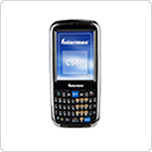A barcode reader can serve many functions. Most people associate barcode readers with the grocery store checkout counter. The handheld devices or flat surfaces the cashier uses to read the barcodes of your items are examples of barcode readers. In fact, understanding what a barcode reader is made easier by continuing the grocery store checkout counter example. A barcode reader is made up of several parts: a scanner, a decoder and a connection to a computer (often via a cable). The barcode must be scanned—think of the thin red lights at a checkout counter. Then, the barcode is decoded, usually by an internal mechanism in the barcode reader itself. Once the barcode is decoded, the information is transmitted to a computer—think of the screen onto which your grocery items and their prices appear—where the data can be stored, transferred and otherwise used. The computer the barcode reader is attached to must use certain software applications designed to work with barcodes. Usually, companies that sell barcode readers or offer barcode reader rentals also provide the necessary software as part of packages they sell to customers. While the grocery store checkout counter is perhaps the most ubiquitous example of a barcode reader in our culture, there are a variety of different types of barcode readers that serve different purposes. Here is a look at the major types of barcode readers and the functions they serve.
Pen Wands
Pen wands are often considered the most basic form of a barcode reader. As with the basic version of most devices, one of its advantages is a relatively low cost. Pen wands are also considered to be highly durable barcode readers. The difficulty with pen wands is that the scanner on a pen wand must be aligned into direct contact with the barcode it is attempting to read. If it is not held at just the right angle and passed over the barcode at just the right speed, it will be difficult to read the barcode. These definitely require some skill and dexterity to operate.
Slot Scanners
Slot scanners are barcode readers that remain stationary while the barcode is moved over the scanner. The barcodes on identification cards are often scanned by slot scanners. They may be usefully implemented by work places that require individuals to clock in using an identification tag.
CCD Scanners
CCD scanners are similar to pen wands but are considered to be higher quality. These are the scanners that are frequently used at grocery stores and in retail stores. CCD scanners have the look of a Star Wars-style blaster gun. Their range is much greater than that of a pen wand. Often, these types of scanners have difficulty reading bar codes that are wider than the glass front of the device. This means they are a good option for grocery stores, but not so effective for keeping track of potentially large inventory items.
Image Scanners

Image scanners, as their name indicates, use built-in cameras to take a picture of the barcode it is attempting to read. These barcode pictures are what are actually decoded by image scanners; this is considered a relatively sophisticated way of reading a barcode. Their range is limited, however, to reading barcodes that are less than a foot away from their scanners
Laser Scanners
Laser scanners have a greater range than image scanners, as they are able to read barcodes that are up to two feet away. In certain cases, laser scanners that are designed to read barcodes from a long distance can read them up to 30 feet away. This would obviously be beneficial for certain warehouse inventory applications. Laser scanners also derive their effectiveness from taking hundreds of scans per second in order to get the perfect read. They can be more expensive, however, than image scanners. With barcode readers, as with most things in life, you get what you pay for.
